Photography is quite literally painting with light. As such, it’s important for a photographer to be able to see and shape light.
If you consider the photographic image, an image is a flat two-dimensional rendering of a three-dimensional object. With this consideration, it’s a valuable skill to have to photograph a three-dimensional thing, show it in a two-dimensional image, but have that two-dimensional image give off the illusion of being three-dimensional.
Zones and Three-Point Lighting
The famous photographer Ansel Adams first considered the idea of zones. For this article, I will work with the example of a tennis ball, although Adams’ primarily is known for developing this concept with his famous landscape images.

If you think of a tennis ball, it’s a three-dimensional sphere and is mostly green all over.
Next, if you imagine a two-dimensional image of a tennis ball, for example, in a children’s coloring book, it’d be the same shade of green all over. In this hypothetical example, I’m sure you can then imagine this image to appear very flat on a flat two-dimensional surface. In this way, it’s a two-dimensional image that appears mostly two-dimensional of what should be a three-dimensional object.
Now, if you instead were to imagine a three-dimensional image of a tennis ball, I’m sure you can imagine gradients of different greens to give the image dimension. It is still a two-dimensional image, but the different shades of green, such as in the image below, make it look three-dimensional. In this way, it’s a two-dimensional image that appears three-dimensional.
It doesn’t really matter whether the image is a photograph or a drawing. But, as this is a photography site, the appearance of dimension is achieved in a photograph through the use of clever lighting and post-production. Even though the actual object might be a solid color, by assigning different shades of that color to its image, it creates an effect of dimensionality within the image.
I have written in further detail about how to achieve three-point lighting previously. If you next try three-point lighting with a sphere, you can apply the concepts a more complex shape. In this case, when working with a sphere, the actual position of the lights becomes more important. Too close or too angled, and the image loses the appearance of dimension.

First, position your key light from behind to create a crescent at the top of the ball. This should give the object a round shape and make it stand out from the dark background.
Next, position a light in front such that there is a gradient on the front of the ball from light on one side to darker on the other. Ideally, the darker side falls into shadow.
Finally, place a reflector on the front of the ball to fill in some of the shadow.
Conclusion
As the saying goes, you have to run before you can walk. First, by working with an object with sides, we learned the basics of assigning values to spaces within an image. Next, by working with a more complex shape, we learn how to further manipulate and shape those spaces within an image.
This article isn’t necessarily about three-point lighting. Instead, consider that an image isn’t a natural thing; what you see isn’t what you get. Instead, there is almost always a degree of manipulation involved in a final result. In this particular case, that manipulation is very controlled.
Additionally, as with the learning of anything, it isn’t about the literal thing you are doing, but rather learning concepts and then building on them. So, with these two exercises, the goal wasn’t to necessarily learn three-point lighting, but that you can apply different values to an image and that you can then also manipulate the shape of those values.










